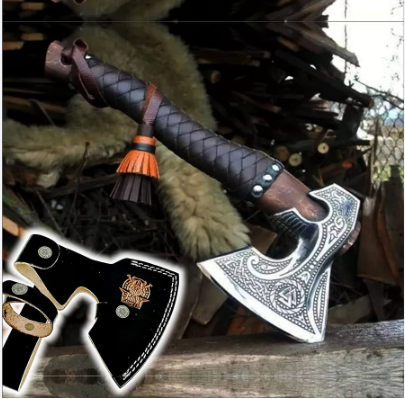Viking axes are iconic symbols of the Norse warrior culture, and their functionality played a crucial role in the daily lives and military endeavors of the Vikings in Denmark. These axes were versatile tools that served various purposes, from mundane tasks to fierce battles. In this article, we will explore the functionality of Viking axes in Denmark, shedding light on their design, uses, and significance in the Viking Age.
Design of Viking Axes: Viking axes were meticulously crafted with a keen understanding of both functionality and aesthetics. These axes typically featured a wide, wedge-shaped blade with a curved edge on one side and a straight edge on the other. The design allowed for effective cutting and chopping motions, making them versatile tools for a range of activities.
Uses in Daily Life: Viking axes were not solely instruments of war; they were indispensable tools for everyday tasks. In agriculture, these axes were used for clearing land, felling trees, and shaping wood for construction. The versatility of the Viking axe made it an essential tool for farmers, woodworkers, and tradesmen alike.
In addition to their use in manual labor, Viking axes also served as symbols of status and were often adorned with intricate carvings or patterns on the handle. The craftsmanship reflected the skill and pride of the axe owner, emphasizing the cultural significance of these tools beyond their utilitarian functions.
Military Functionality: While Viking axes had practical applications in daily life, they truly excelled on the battlefield. In the hands of skilled warriors, these axes became formidable weapons. The broad cutting edge could deliver devastating blows, while the pointed top of the axe head could pierce armor.
Viking warriors, known for their agility and ferocity in battle, wielded axes with precision and strength. The design of the Viking axe allowed for both slashing and thrusting motions, making it a versatile weapon on the battlefield. Historical accounts and archaeological findings attest to the effectiveness of Viking axes in raids, invasions, and conflicts during the Viking Age.
Cultural Significance: Norse axes not only served practical purposes but also held cultural and symbolic significance. In Norse mythology, axes were associated with gods like Thor, further elevating the importance of these weapons in the Viking worldview. The symbolic value of the axe was also evident in burial practices, where warriors were often interred with their weapons as a representation of their identity and status in the afterlife.
The functionality of Viking axes in Denmark was multi-faceted, ranging from mundane tasks in daily life to the brutal realities of warfare. These axes were not just tools but cultural symbols that embodied the craftsmanship, strength, and identity of the Viking people. Today, the legacy of Viking axes continues to captivate historians and enthusiasts alike, providing a glimpse into a bygone era of Norse history and the remarkable functionality of these iconic weapons.

